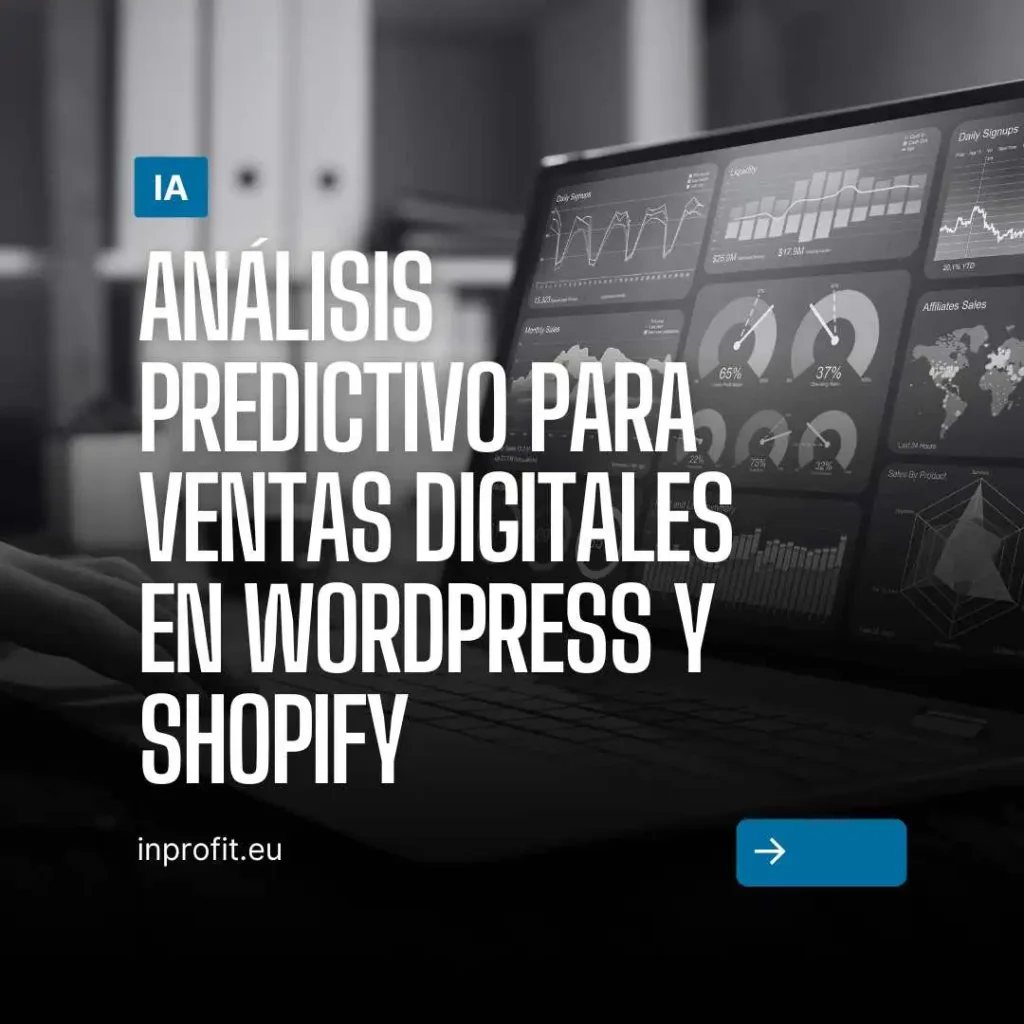E-commerce is no longer just about having an attractive online store or a solid marketing strategy. Today, the difference between success and stagnation lies in the ability to anticipate customer decisions. And this is where predictive analytics, one of the most powerful tools for digital sales on platforms like WordPress (with WooCommerce) and Shopify, comes into play.
But what happens when you combine these platforms with artificial intelligence? You get a hyper-personalized conversion machine, capable of predicting buying behavior, optimizing inventory and maximizing ROI with previously unthinkable accuracy.
In this article, we will not only explore how predictive analytics works in ecommerce, but we will also show you how to implement it in your online store, regardless of whether you use WooCommerce or Shopify. Get ready to discover strategies that your competitors are not yet applying.
Predictive analytics in ecommerce Why?
Predictive analytics is not just a trend; it is a necessity in a market where the saturation of competitors and the reduction of user attention forces brands to be smarter. Unlike traditional methods, which rely on historical data to make reactive decisions, this technology uses machine learning algorithms to project future scenarios with a high degree of accuracy.
According to a McKinsey study, companies that implement predictive models in their digital sales strategies experience a 10-20% increase in conversions and up to a 30% reduction in acquisition costs. This is because AI not only analyzes the past, but identifies hidden patterns that a human team might miss.
But the real value of predictive analytics goes beyond the numbers. It’s about creating personalized experiences at scale, anticipating customer needs before they are even aware of them. From product recommendations to automated discounts, the possibilities are endless for those who know how to leverage this technology.
But how does it achieve this?
- Anticipating demand: AI analyzes historical patterns to predict which products will have the highest turnover.
- Real-time personalization: Segment users based on their behavior and show them what they are likely to buy.
- Inventory optimization: Reduces overstock and avoids losses due to obsolete products.
If your online store is not yet taking advantage of these capabilities, you are leaving money on the table.
WordPress + WooCommerce How to integrate Predictive AI?
WooCommerce is the most widely used ecommerce solution in WordPressbut many stores operate with reactive strategies instead of predictive ones. The good news is that you don’t need to be a data scientist to implement predictive analytics on your site. Platforms like Google Analytics 4 (GA4) already incorporate machine learning models that can be leveraged even by non-technical users.
Key tools for WooCommerce:
- Google Analytics 4 (GA4) + Machine Learning: The latest version of GA4 uses AI models to predict metrics such as churn rate and purchase probability.
- WooCommerce Predictive Search: Plugins like Searchanise or PredictiveSearch use algorithms to display results based on purchase intent.
- Dynamic Pricing Engines: Solutions such as Inprofit together with Synsight Hub have developed solutions that automatically adjust prices according to demand and competition.
One notable success story is that of a fashion retailer that implemented a predictive model in WooCommerce and achieved 28% more cross-sales by recommending complementary products based on browsing history.
Shopify and the power of native AI
Shopify has natively integrated artificial intelligence into its ecosystem, making it one of the most advanced platforms for predictive analytics. Unlike WooCommerce, which requires third-party plugins for this functionality, Shopify offers proprietary tools specifically designed to optimize digital sales with minimal configuration.
Shopify exclusive features:
- Shopify Audiences: Uses machine learning to identify high-value shoppers on Facebook and Instagram.
- Smart Recommendations: Suggests products based on deep learning algorithms.
- Shopify Flow: Automates actions such as personalized discounts when a customer is about to abandon the cart.
A real-world example: An electronics brand on Shopify reduced their CPA (Cost Per Acquisition) by 22% by using audience predictions to optimize their Meta Ads campaigns.
Automation: Can AI replace creativity?
While predictive analytics is incredibly powerful, it is still a tool, not a substitute for human judgment. Creativity in marketing-from copywriting to design-is stillkey to connecting emotionally with the customer. AI can tell you what to sell, but only you can decide how to sell it to them.
However, this does not mean that you should underestimate the role of artificial intelligence in the creative process. Tools like ChatGPT or Jasper.ai are already being used by marketing teams to generate ideas, optimize copy and even design content strategies. The real potential lies in combining the power of data with human intuition and experience.
Ultimately, success in digital sales will depend on your ability to balance both worlds. Use predictive analytics to make data-driven decisions, but don’t forget that behind every click is a person with unique needs, emotions and desires.
How to get started with predictive analytics on your website?
If you’re ready to take your digital sales to the next level, follow these steps. The first step is to collect quality data. Use tools like Hotjar, GA4 or Kissmetrics to understand user behavior in your store. The more accurate your data is, the more effective your predictive models will be.
The second step is to choose the right platform. WooCommerce is ideal for those looking for flexibility and full control over their store, while Shopify offers integrated AI solutions that make the process easier. Once the platform is selected, choose specific tools such as predictive chatbots or recommendation engines to boost your results.
Finally, measure and adjust. AI models improve over time, so it is crucial to monitor metrics such as CLV(Customer Lifetime Value) and retention rate. Perform A/B tests constantly and adjust your strategy according to the results. Remember that predictive analytics is not a one-time project, but a continuous process of optimization.
If you are ready to take your digital sales to the next level, follow these steps:
- Collect Quality Data: Use tools such as Hotjar, GA4 or Kissmetrics to understand user behavior.
- Choose the Right Platform: WooCommerce for flexibility, Shopify for scalability with integrated AI.
- Select Specific Tools: From predictive chatbots to recommendation engines.
- Measure and Adjust: AI models improve over time. Review metrics such as CLV (Customer Lifetime Value) and retention rate.
Are you ready for the future of digital sales?
Predictive analytics is no longer exclusive to giants like Amazon. With WordPress, WooCommerce, and Shopify, any business can harness the power of artificial intelligence to sell more and better. From advanced personalization to inventory optimization, the possibilities are endless for those who dare to embrace this technology.
The question is: Which predictive strategy will you implement first in your online store? Automated recommendations? Dynamic pricing? Or perhaps advertising campaigns based on predictive audiences?



